My new dog Wally has been with me for about 2 months now. We seem to bond a little more every day as we continue to figure each other out and work together on navigating obstacles in our training path, both figuratively speaking and sometimes even literally!
“Stay” inside the house was the second command he mastered fairly quickly, right after “sit.” I’m currently working with him on holding his “stay” around distractions in different environments, both indoors and outdoors.
Let me tell you that it’s a wonderful way to engage both of us mentally! Wally’s learning to stay focused on me, and I’m having to come up with ways that motivate him enough to find me more interesting than distractions.
In order to practice the stay command around distractions, your dog should already be able to hold a stay position in a neutral environment, at least for a few seconds.
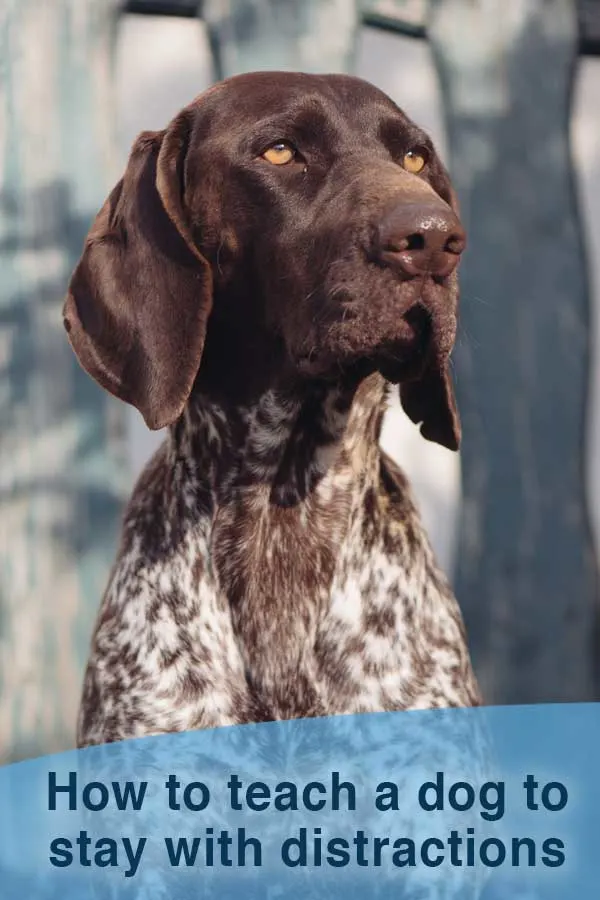
How to teach your dog to stay
Along with sit, down, and come, the stay command is considered one of the basic commands every polite dog should know.
Start by teaching your dog to stay in a neutral environment rather than including distractions right away. This will set him and yourself up for success. Like with all dog training, consistent and short sessions work best.
Figure out what motivates your dog and use it to your advantage as a reward. This could either be tasty high value treats, a favorite toy, or praise and lovings from you, his owner. Along with the reward, use a cue word or a clicker when your dog performs the desired behavior and stays put.
Lindsay wrote an insightful article about the “stay” command that I recommend you check out if your dog doesn’t have a reliable “stay” quite yet:
5 Tips For Teaching A Dog To Stay Reliably
Benefits of teaching your dog to stay around distractions
Moving on from the basic “stay” in a neutral environment, teaching your dog to “stay” around distractions has several benefits:
1. “Stay teaches your dog impulse control to keep him out of trouble
Keep him from running out of an open door and/or into a busy street, knocking over fragile aunt Frannie, or chasing the neighbor’s cat.
2. “Stay” teaches a dog good manners
Be in control of your pup and keep him from leaving muddy paw prints on your carpet after that awesome romp around the wet yard, keep him put in the tub during bath time, and out of your feet when fixing/eating dinner.

3. Working on “stay” helps you bond with your dog
Enjoy your dog paying attention to you and looking to you for guidance.
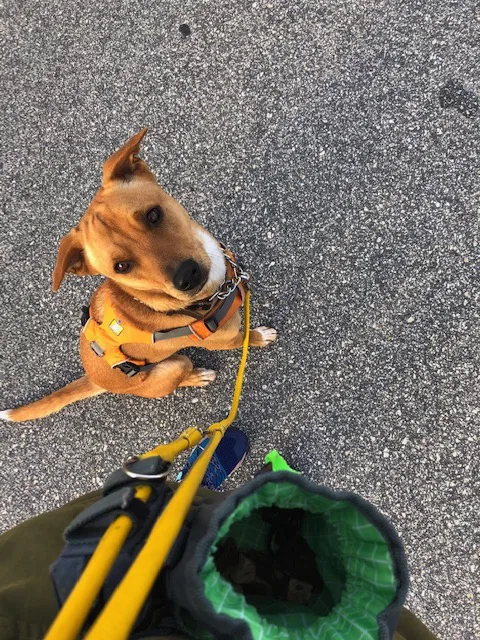
I personally decided to work on Wally’s “stay” around indoor distractions first before we moved on to outdoor distractions. That’s because it’s an environment I’m more in control of as opposed to the busy outdoors.
Decide which distractions you want to work on, then start with short distances at which you ask your dog to hold his “stay” and gradually increase them.
Tools to teach your dog to stay around distractions
I have found and continue to find the following tools helpful in improving Wally’s willingness to “stay” around distractions:
1. A doggie backpack to put him into a working mindset.
This helps, especially when running errands and when working with him outside. He’s able to focus considerably better on me when wearing one, especially when we’re surrounded by animal distractions.
Wally’s wearing the Ruffwear Commuter Backpack in the pictures throughout this blog post, but there are several other brands who make doggie backpacks as well (Outward Hound, Olly Dog, and many more. Just do a Google search).
2. A leash in order to redirect him when something breaks his “stay.
This also helps keep him put when working on stay with an open front door, people visiting, or a highly distracting outdoors environment.
Multifunctional leashes work best for this purpose because they feature a double ended clip. A long dog leash works great because you can slowly work on more distance. You could also clip it around around a sturdy object or tree.
3. Martingale collar for a quick reminder to pay attention.
I currently use a martingale collar with Wally, and another good option is a Gentle Leader or Halti for training purposes.
4. Treat pouch filled with high value treats.
It’s super helpful having treats handy when you need to reward good behavior and not having to dig around for them in your pockets. A treat pouch could potentially also hold your phone, keys or poop bags.
5. Another dog who already knows how to stay around distractions!
Goldendoodle Lulu is a therapy dog and extremely well behaved, so having her around on walks with Wally helps him simply by being able to copy her behavior.
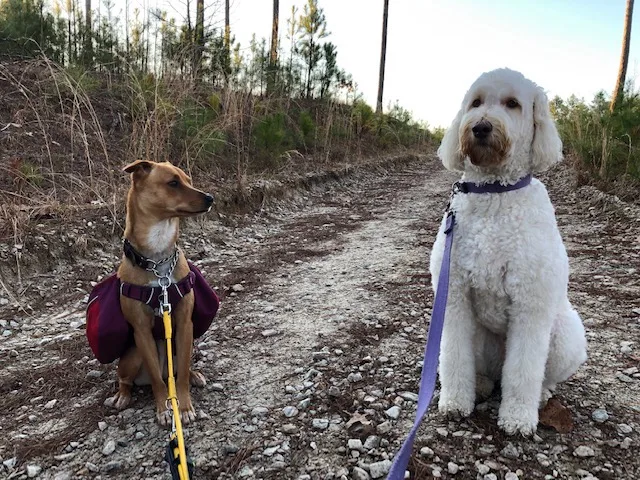
How to teach a dog to stay with distractions inside the home
You can practice stay inside your home around many distractions. Some ideas are:
- Food, both your pup’s and your own
- Door bell
- Open front door, back door or garage door
- People visiting
Teaching your dog to stay around food
The first inside distraction I worked on with Wally was his food. Polite doggie behavior around any type of food is very important to me personally, so asking him to stay reliably before digging into his raw meals was a training priority for me.
I first asked him to hold his stay while he was sitting next to me and his filled bowl was sitting on the kitchen counter right in front of us. I gradually increased the distance between him and the food bowl, and am happy to report that he can now hold his stay 10 feet away from the bowl. His reward is mealtime!
See my post: Keeping your dog calm before meals.

How to teach a dog to stay when visitors arrive
Next on my list of training priorities was him being able to stay put when friends are visiting and first coming through the door.
I found it helpful to instruct guests to ignore Wally at first. This helps in keeping his level of excitement low and being able to better concentrate on what’s expected of him.
I would first leash him to my fridge using a multifunctional leash, and this method worked like a charm. When working on this challenge, you could ask your pup to “stay” on his bed, in his open crate, or any other place of your choosing when guests first arrive.
Keeping a leash on him certainly helps during the initial training phase. You could attach it to a banister or a furniture leg as well.
Teaching your dog to stay when the doorbell rings
Interestingly enough, the sound of the doorbell doesn’t represent any form of distraction to Wally at all, so that works out in my favor!
Don’t think I lucked out too much though…check out the section on our personal challenges to find out what REALLY gets him and keeps him from concentrating on me!
Something to incorporate with your pup when working on his “stay” at the sound of the doorbell is to ring it after you come back from a walk. Have your pup “sit” or “down” by the front door, and ring the door bell.
Reward him for staying put with high value treats like cut up hot dog, green tripe treats (my favorite training treats), or anything else that has a distinctive smell to it.
I used to practice this with my pups Missy & Buzz and it became a ritual for us to ring the door bell whenever we came back from our walks. It had the wonderful effect of not causing crazy excitement when somebody other than me rang it.
See our post: Teach your dog not to bark at the doorbell
How to teach your dog to stay in public
If you want to take indoor distractions up a notch, practice the stay command when you’re out running errands at pet-friendly locations. Try exercising your dog physically to burn some energy before you take him out on those training adventures. He’ll likely be calmer and able to better focus on you.
You can practice at pet retail locations and stores like:
- Tractor Supply
- Lowe’s and
- and Home Depot
Most of them are dog friendly, but double-check their respective store policies before taking your dog. Also check to see if your favorite winery, restaurant or bar might have a dog-friendly al-fresco area.
A multifunctional leash will come in very handy in those locations – simply attach it to a leg of the table you’re sitting at (or chair you’re sitting on), and working on the “stay” will become a breeze.
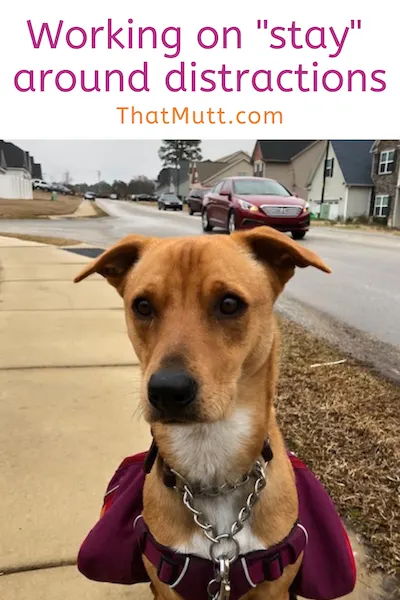
Some distractions you and your dog will encounter at those locations are:
- other people
- kids
- dogs
- aisles of toys
- treats
- food
- small animals for sale like birds, fish, and guinea pigs.
Don’t forget to arm yourself with tasty high-value treats or your dog’s favorite toy to entice and reward good behavior!
Another great opportunity to improve your dog’s ability to hold his stay are trips to your vet’s or groomer’s. He’ll be able to practice focusing on you instead of other pet patients and grooming clients.
A dog training facility gives you the opportunity to practice your dog’s impulse control specifically around other dog students in a controlled environment. It’s certainly on Wally’s and my list of things to do.
How to teach your dog to stay when you’re outdoors
Yet another level of distractions are those you come across in the great outdoors. The ones that come to mind are:
- Your yard: Small animals like squirrels, rabbits, cats, birds, people walking by your fence, a favorite toy you throw for your dog!
- Walks in your neighborhood: Cars and motorcycles, bikes and strollers, wild animals like geese/ducks (especially in areas where ponds and lakes are prominent), barking dogs in yards you walk by
- Hikes in parks: Joggers and fellow dog walkers
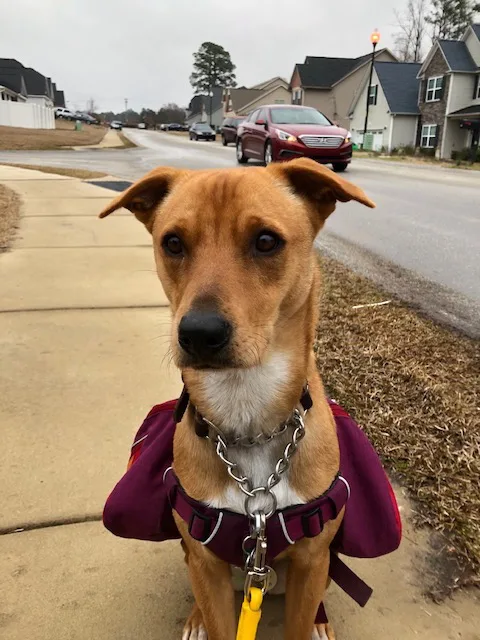
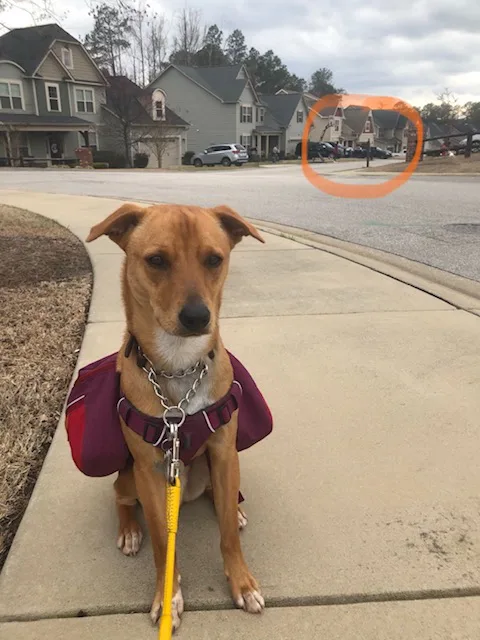
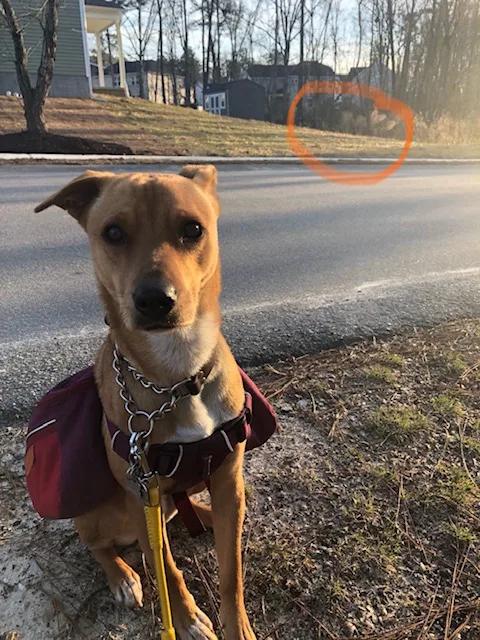
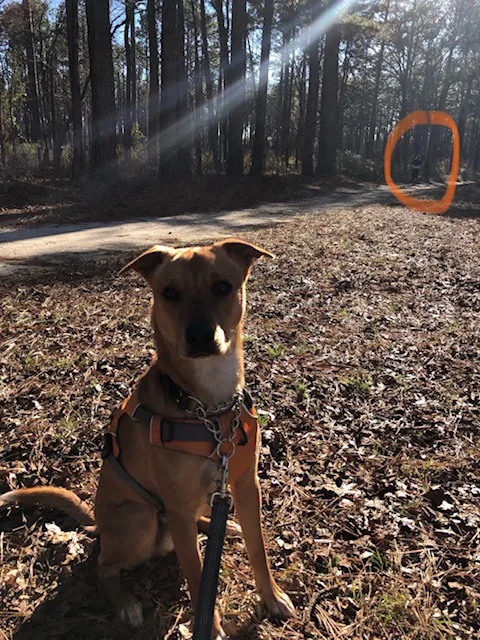
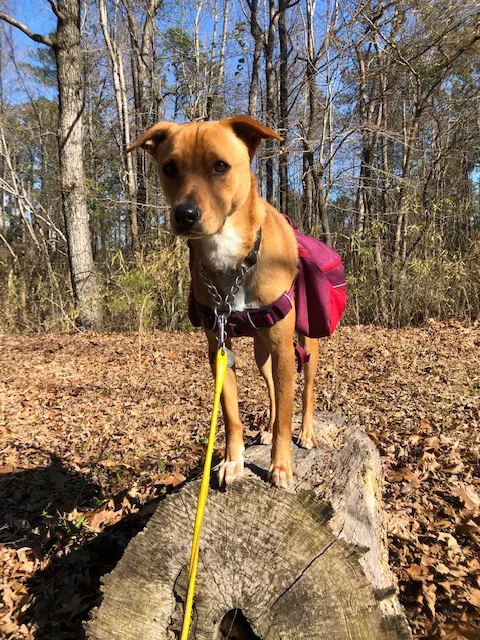
Distractions that are still challenges for Wally and I
Wally’s “stay” around people and moving objects like cars, motorcycles, and bikes is really good and continues to improve weekly, but our personal challenges are animals, especially:
- cats
- squirrels
- other dogs
- and geese
Wally LOVES chasing cats and is still extremely distracted by them both on walks and in the backyard. So far, he’s unable to hold a “stay” at all when cats are around, even with Goldendoodle Lulu being 100% calm next to him!
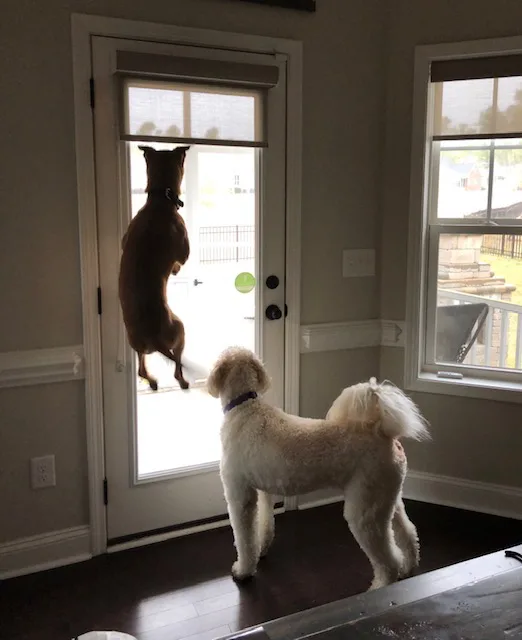
The only way I figured out of redirecting him from his cat craziness is by physically removing him from the cat surroundings.
I’ll usually put a leash on him and take him outside for a quick 5-minute walk to snap him out of his overly excited state of mind. Or I’ll walk him into a different room.
He’s able to calm down and focus on me when we move to a different location together, but even the most high-value treats can’t trump cats for now when they’re within sight. I don’t know if that’ll change at some point – we’ll see and I’ll keep you posted!
He’s similarly excited around squirrels, although I’m able to redirect him eventually by holding a high value treat right under his nose and slowly moving it away from the direction the squirrel is in.
I’m also able to redirect his focus when I’m asking him to “sit-stay” in close proximity to a fenced-in yard with a barking dog on the other side of the fence.
The same goes for encountering geese on our walks around the neighborhood pond area. A tasty, high-value treat held under his nose and moved in the opposite direction of the geese works surprisingly well.
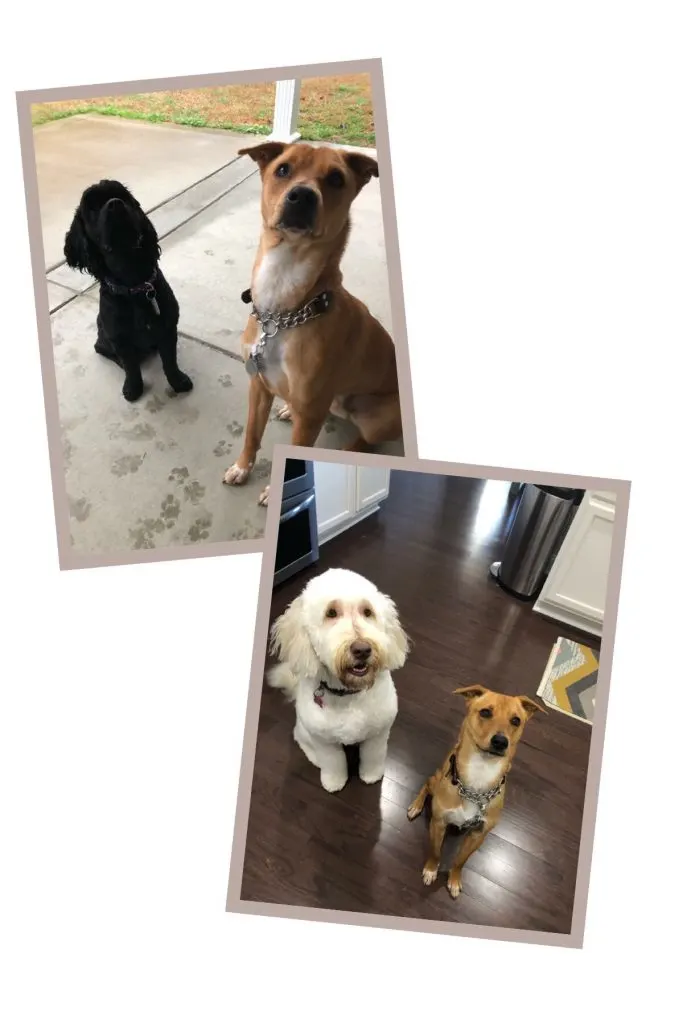
Final thoughts on teaching your dog to stay around distractions
Mastering the “stay” around a varying degree of distractions is no easy task, but it’s well worth pursuing. It boosts our dogs’ confidence and can keep them out of trouble and potentially dangerous situations.
Wally and I are continuing to make progress on this leg of our training journey, but we still need to master the cat obstacle.
I’m not sure if he’ll ever be able to fully concentrate on me when his feline nemesis are around. It would be nice if I could at least tone his excitement level and bounciness down a little!
Does anyone have some advice regarding Wally’s issues around cats?
Also, how does your dog do with “stay” around distractions? Do you have any good challenges the rest of us could try?
Let us know in the comments!
Barbara Rivers writes about raw dog food, dog training and life with her newly adopted dog, Wally West. She owns her own dog walking and pet sitting business in North Carolina. Wally is an active, 1.5-year-old Feist mix. Follower their blog K9s Over Coffee.

Janet
Tuesday 1st of December 2020
These are such great tips. The doorbell is a huge issue for us. I'll try ringing it when we come back from our walks and runs to see if that helps.
Cheryl A
Sunday 29th of November 2020
Have you worked on sit, or down/ stay while throwing or rolling tennis balls or other favored toys past him? I use tease poles too. I did that before adopting cats as well. Sophie’s biggest distraction is squirrels. We have worked her past the ducks at the lake.
Kim Chappell
Thursday 27th of February 2020
Train LEAVE IT , which means the dog is to disengage completely from whatever they are looking at - which can be other dogs, humans, or cats/squirrels. Proofed often under gradually harder circumstances this is one of my favorite commands. Consistently keeping yes and no very clear to the dog is key. I start training LEAVE IT by using food. Dog is rewarded when he ignores it. My ACD works for all his meals, the food is used as rewards for his training. Hand feeding gives the human “value” to the dog, instead of giving the dog bowl “value” . Hand feeding also helps eliminate some resource guarding, as there is no dog food bowl to guard.
Lesley Roberson
Saturday 8th of February 2020
What do you put in Wally's backpack on your training adventures??
Lindsay Stordahl
Saturday 8th of February 2020
I out paperback books in my weimaraner's pack.
Ann @ HappyJRT
Monday 8th of April 2019
Great article!
I'm sure that step by step you'll manage to curb his cat enthusiasm.